Introduction: Your Family Camping Checklist
When people ask me what they should bring on a family camping trip, I always tell them it’s a loaded question. The answer depends entirely on where you’re going and how you’re getting there.
Table of Contents
ToggleThere are two primary types of camping experiences you’ll encounter:
Camping Types: Car Camping vs. Deep Woods
Car Camping: This is what most families do. You drive directly to your campsite, which means you can pack your vehicle as full as you want with comfort items and conveniences. Weight and space aren’t major concerns since you’re not carrying everything on your back or in a canoe.
Deep Woods Camping: This is what I typically do – heading into the wilderness with everything packed in a canoe. This style requires packing light and being selective about what you bring.
Today I’m focusing mainly on car camping essentials – the gear that makes family camping comfortable and enjoyable when you can drive right up to your site.
The Importance of Preparation
Before we dive into specific gear, I need to emphasize how crucial preparation is for family camping. I’ve been camping for over 60 years, and I can promise you that proper preparation makes the difference between a memorable adventure and a miserable experience.
One of the first skills you’ll want to develop is reading the weather. Learning to identify cloud formations like ultracirrus clouds (those thin, sheer curtains across the sky) can help you anticipate incoming weather and prepare accordingly.
When you arrive at your campsite, your first job is setting up shelter – which means your tent should be your top priority. I always tell people to set up and test their camping gear at home before heading out, especially if you’ve got a new tent. You don’t want to be figuring out complicated poles in the pouring rain!
Throughout this guide, we’ll cover the essential family camping gear you’ll need, from the absolute must-haves to the comfort items that make outdoor living more enjoyable. Let’s start with the most important piece of gear: your tent.
==Downloadable checklist
TLDR: Family Camping Essentials Guide
The Basics:
- Tent: Buy bigger than you think you need (a 4-person tent comfortably fits 2 people). Always choose waterproof, not water-resistant. Set up at home first to practice.
- Sleeping: Options include cots (comfortable but bulky), self-inflating pads, or foam pads. Bring sleeping bags rated for colder temperatures than expected.
- Seating: Pack chairs for everyone – options range from lightweight ground chairs to comfortable folding camp chairs.
Cooking and Food:
- Bring a two-burner stove, even if you plan to cook over fire
- Pack cookware that’s campfire-safe or dedicated camping cooksets
- Consider a cast iron skillet for amazing campfire flavor
- Don’t forget heat-resistant gloves and cooking utensils
Don’t Forget:
- Toilet paper! (The most commonly forgotten essential)
- First aid kit with basics plus any family medications
- Lighting (headlamps and lanterns)
- Charging options for devices (solar chargers work well)
- Bug protection (including a screen tent if possible)
- Fire starting tools and matches
Campsite Expectations:
Most drive-in campsites include a fire pit/ring and picnic table. Facilities vary by location but typically include washrooms and water access nearby.
The key to successful family camping is preparation, flexibility, and embracing the outdoor experience. Test gear before you go, pack for comfort but don’t go overboard, and focus on creating memories rather than perfection.
Setting Up Camp: The Essentials
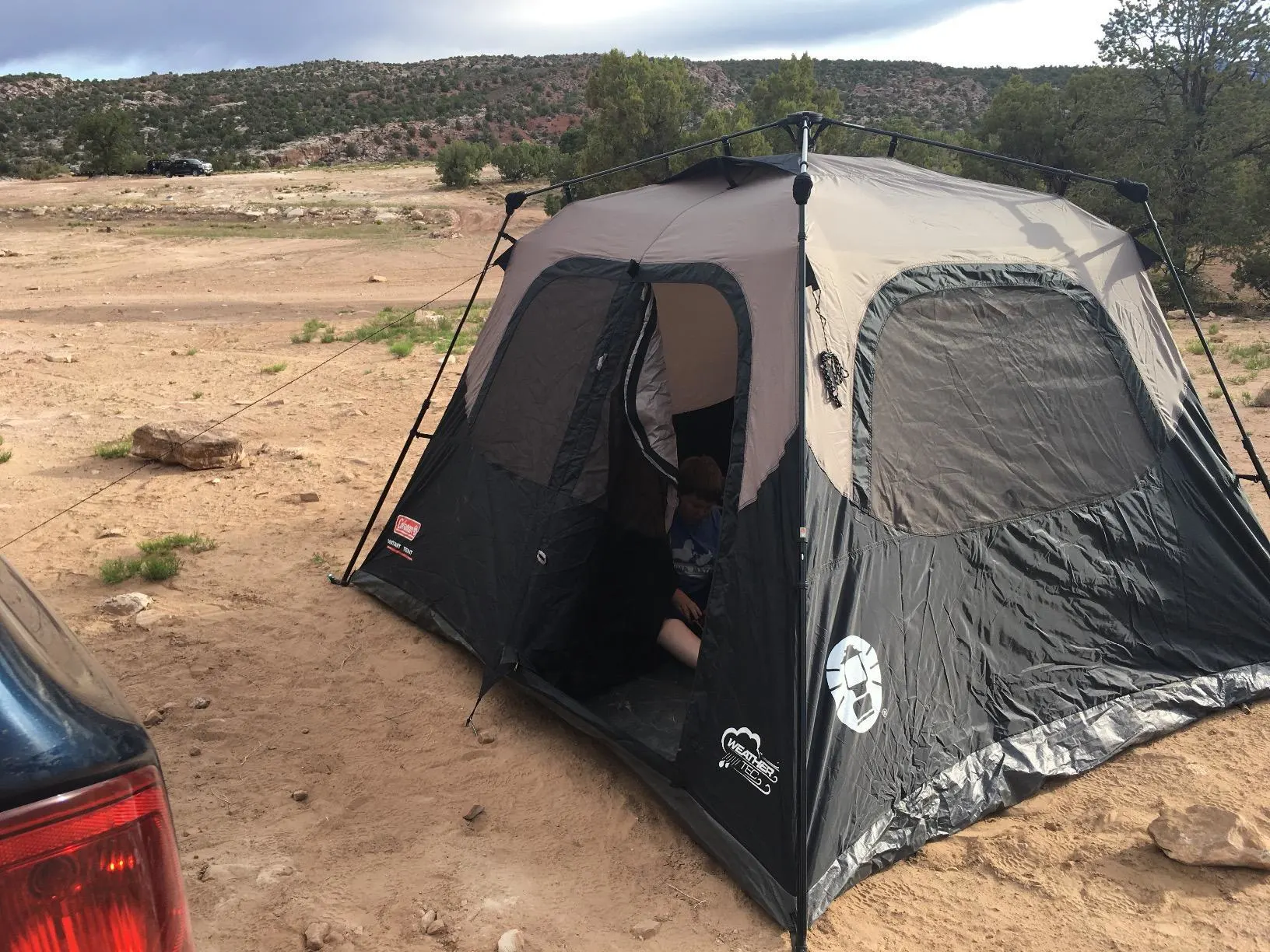
A. Choosing the Right Tent
Your tent is the most important piece of equipment you’ll bring to camp. It’s your shelter, your home away from home, and your protection against the elements. Selecting the right one can make or break your family camping experience.
Tent Size Recommendations
When it comes to tent sizing, here’s a crucial tip: always go bigger than you think you need. Manufacturers often exaggerate how many people can comfortably fit in a tent.
- A 2-person tent is really comfortable for 1 person plus gear
- A 4-person tent is ideal for 2 people
- A 6-person tent works well for 4 people
- An 8-person tent is great for a family of 4-5 with gear
If you have a four-person family, I strongly recommend a six to eight-person tent. Don’t try to squeeze everyone into a tent that technically fits your headcount but leaves no room for moving around or storing your stuff. Remember, you’re car camping—take advantage of that extra space!
Waterproof vs. Water-Resistant
When buying a tent, never settle for “water-resistant.” This is absolutely critical. A water-resistant tent will get you soaked in a real downpour, and you’ll end up rigging tarps over it, which defeats the whole purpose.
Always check the specifications and make sure your tent says waterproof, not water-resistant. This is especially important when camping with family, as there’s nothing worse than trying to manage cranky, wet kids in the middle of the night.
Setting Up Your Tent at Home First
This tip has saved me countless headaches over decades of camping. Always, always set up your tent at home before your trip. This practice run accomplishes several important things:
- Ensures all parts are included and functioning
- Helps you learn the setup process without pressure
- Identifies any defects or issues before you’re at the campsite
- Builds your confidence in setting it up quickly
You never know when you’ll arrive at your campsite with rain clouds looming. Being able to quickly set up your tent can make all the difference.
Tent Placement Tips
When you arrive at your campsite, take time to survey the area before setting up:
- Look for level ground with minimal roots and rocks
- Don’t chop out tree roots – this damages the trees and ecosystem
- Check overhead for dead branches that could fall
- Position away from areas where water might collect
- Face the door away from prevailing winds if possible
Many tent setup guides tell you to stake down your tent first, but I disagree. Set up the structure first, then position it exactly where you want it, and finally stake it down. This allows you to adjust the placement for the perfect spot.
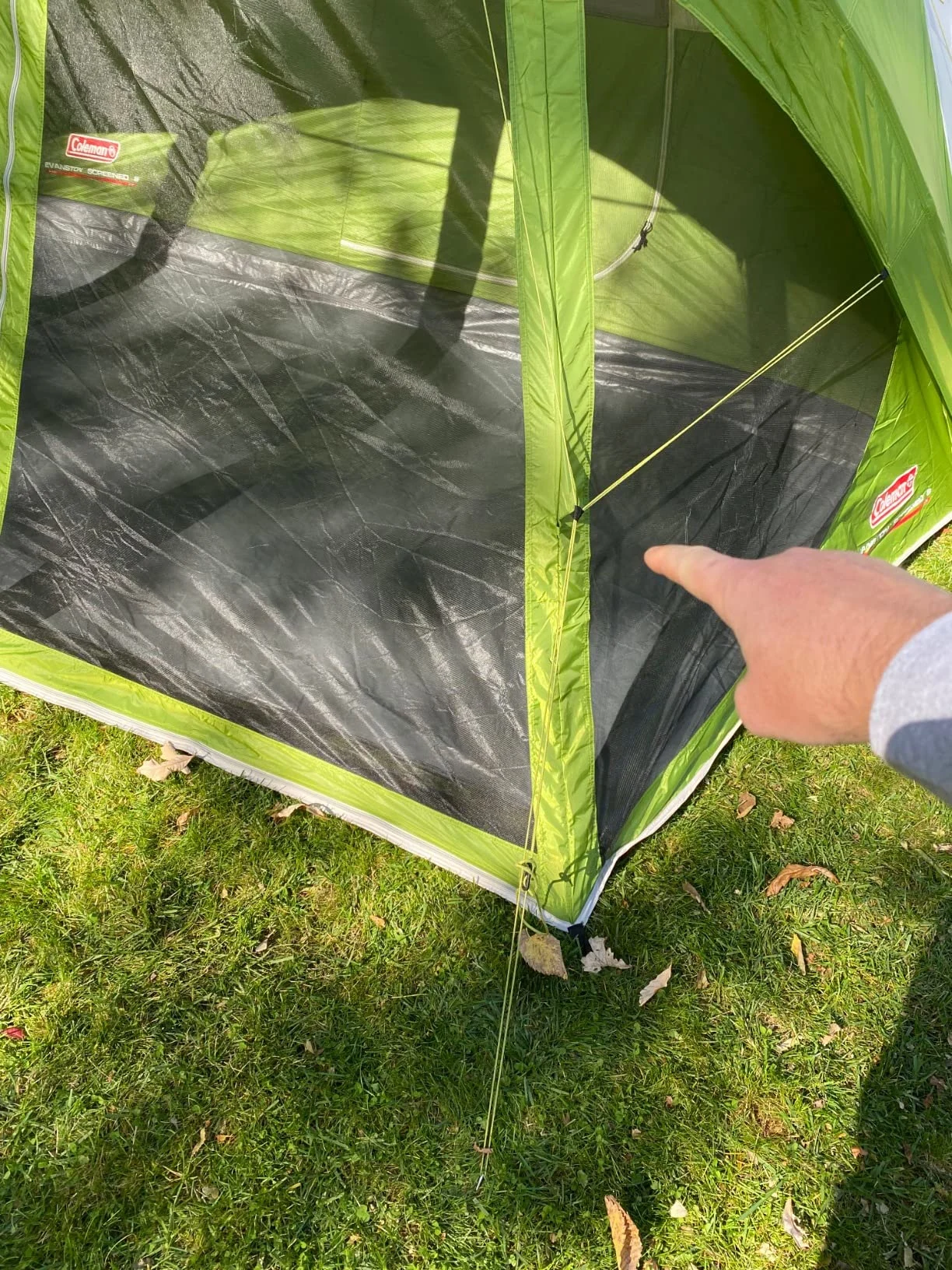
Tent Features: Screen Porches, Storage
The tent I’ve used for years has some fantastic features worth looking for:
- Screen porch: A game-changer for family camping, offering bug-free lounging space and a place to remove muddy shoes before entering the sleeping area
- Multiple doors: Makes entering and exiting easier without disturbing others
- Storage pockets: Internal pockets keep small items organized and off the floor
- Vestibules: Additional covered space for storing gear outside the sleeping area
- Weather-resistant seams: Taped or sealed seams prevent water from seeping through stitching
One caution about screen porches: they’re great spaces, but avoid eating in them, especially in bear country. Even crumbs can attract wildlife from chipmunks to larger predators.
check out our review about testing 16 family tent with different features and prices, here.
B. Sleeping Systems
After shelter, your sleeping system is the next most important factor in camping comfort. There are several options depending on your comfort preferences and space constraints.
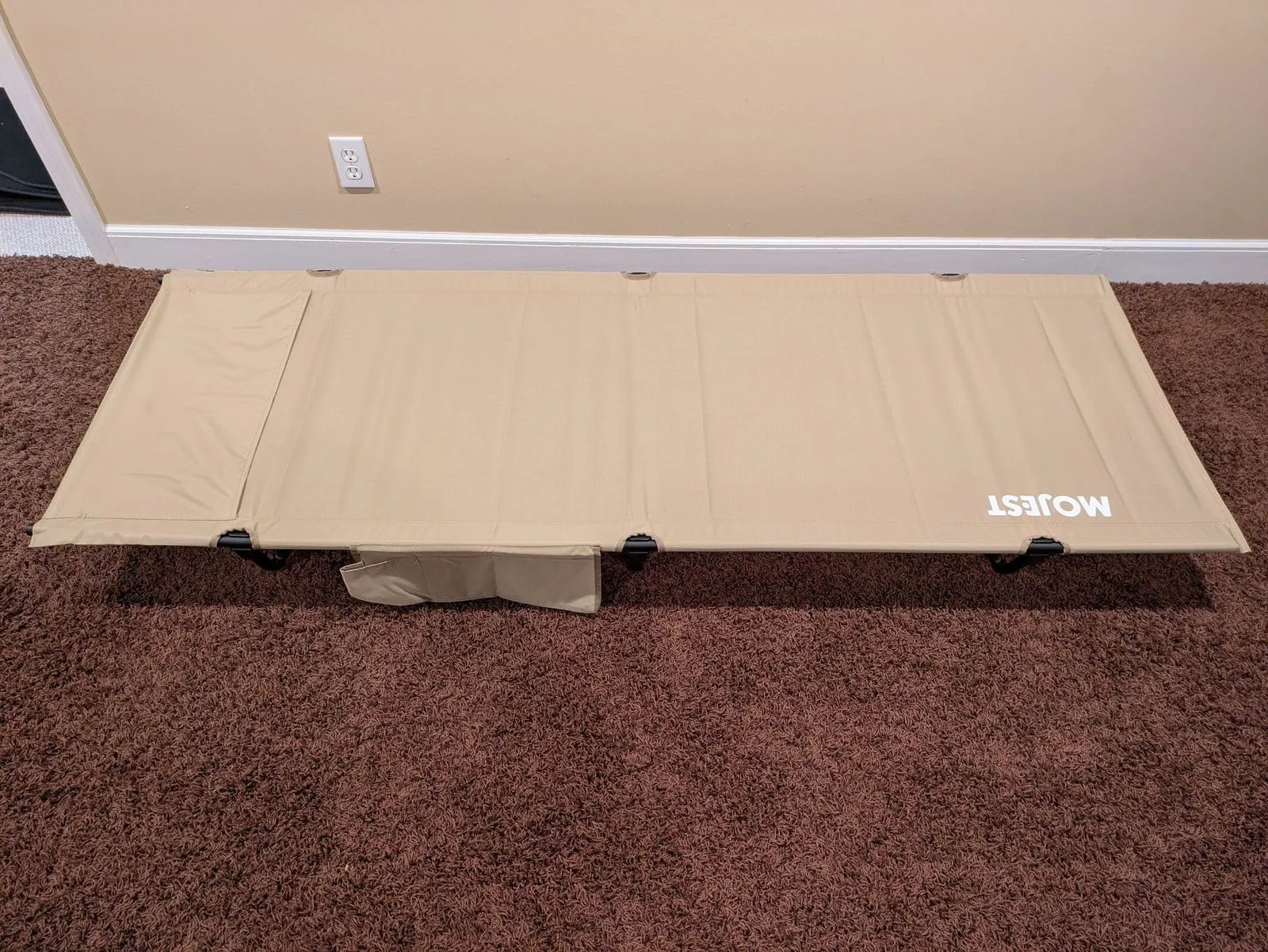
Cot Options and Considerations
Camp cots offer a luxurious sleeping experience because they get you up off the ground. Benefits include:
- Keeps you away from the cold ground
- Provides storage space underneath
- Often more comfortable for those with back issues
- Easier to get in and out of than floor sleeping
The main drawback of cots is their size and bulk. A four-person tent might only comfortably fit two cots with walking space between them. They’re also heavier and take up significant car space, but for car camping, they’re worth considering for comfort.
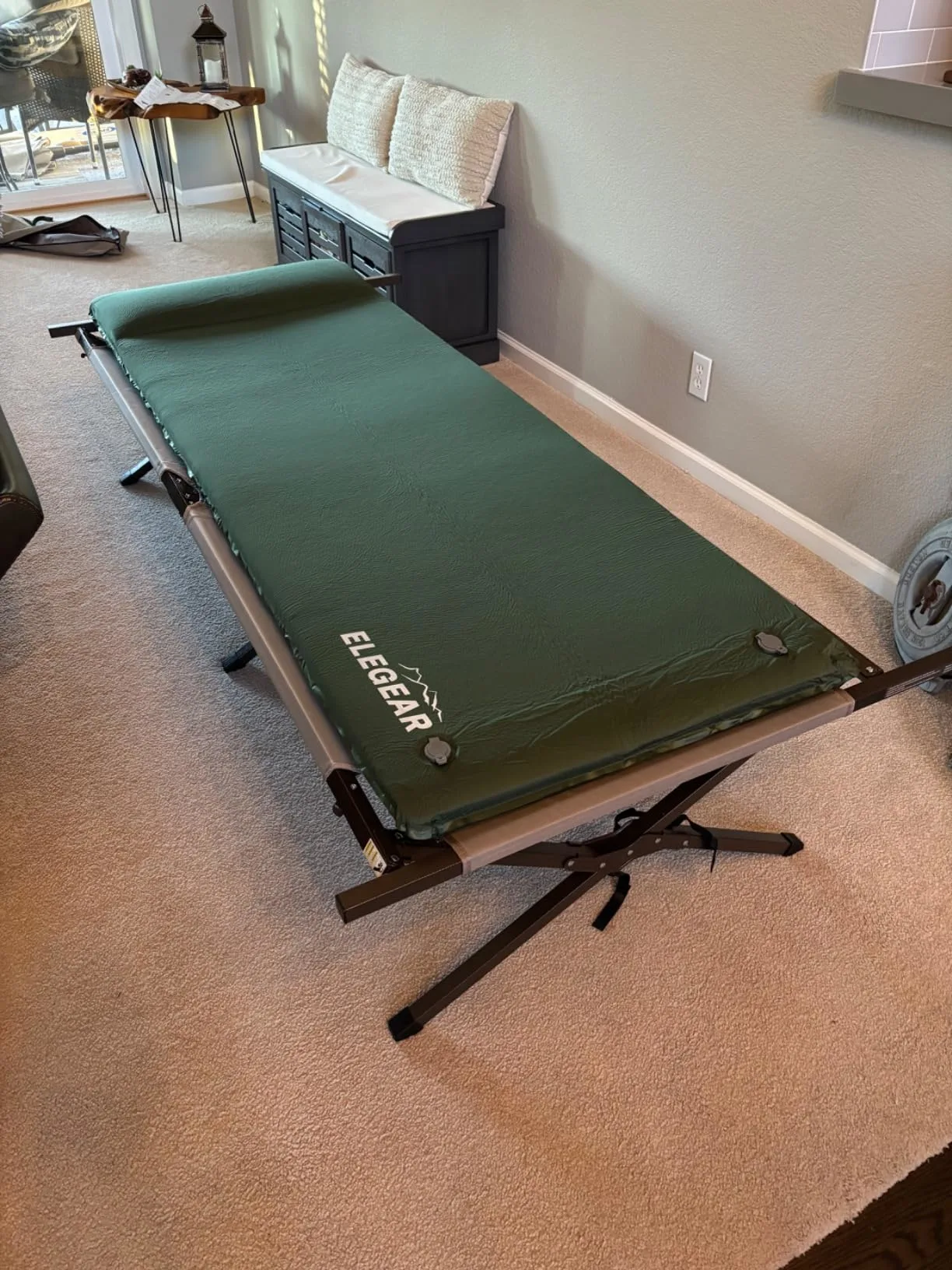
Sleeping Pad Options
There are several types of sleeping pads to consider:
Self-Inflating Pads: These expedition-style mats (like the North 49 from Costco) are incredibly comfortable. They self-inflate when you open the valve and provide excellent insulation and cushioning. They take up more space than foam pads but less than cots.
Closed-Cell Foam Pads: Like the Thermarest Z-Light Sol, these lightweight pads fold up accordion-style. They have a reflective layer for warmth and are nearly indestructible. They’re my go-to for canoe trips because they’re light and compact, though not as plush as inflatable options.
Air Mattresses: While not mentioned in our discussion, air mattresses are another option for family car camping that provide good comfort but require inflation equipment.
For maximum comfort when car camping, you can even combine systems – place a self-inflating pad on top of a cot for the ultimate outdoor bed!
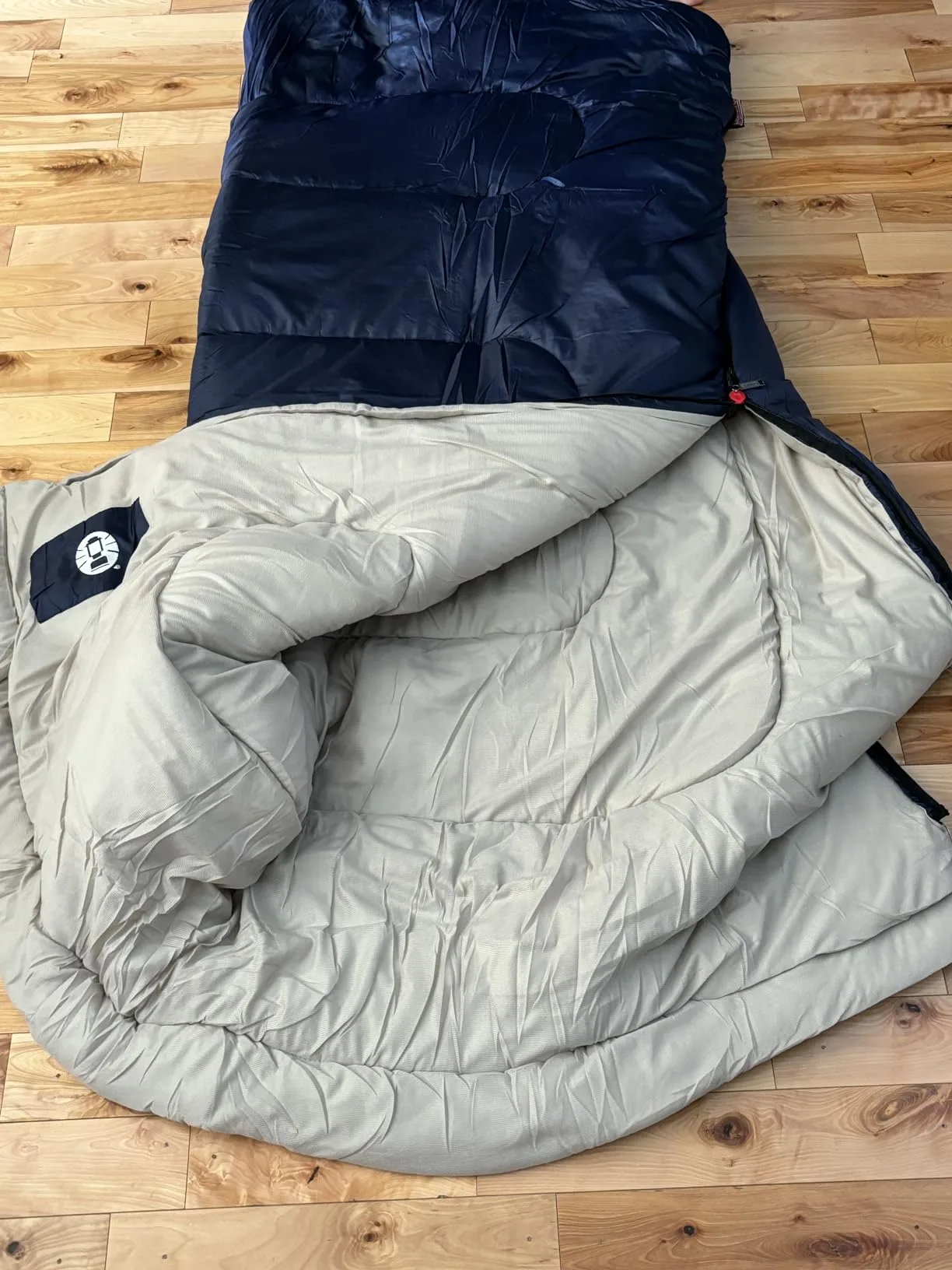
Sleeping Bag Recommendations
When selecting sleeping bags, temperature rating is crucial:
- Don’t trust the ratings on the bag – they’re often optimistic
- Choose a bag rated for at least 0°C (32°F) even for summer camping
- Temperatures can drop surprisingly low even in July and August
- Avoid down-filled bags for family camping – when wet from rain or body moisture, down loses its insulating properties
- Synthetic-filled bags maintain warmth even when damp
For car camping, bring extra blankets as backup. Weather can be unpredictable, and it’s better to have too many warm layers than too few.
Pillows
Don’t forget pillows! While you could bring your pillows from home, compact camping pillows like the Thermarest compressible pillow pack down small and fluff up for comfortable sleeping. They take up minimal space in your car and add significant comfort to your camping experience.
Essential Tent and Sleeping Gear Recommendations
Tents:
- Woods™ 6-Person Tent at Costco
- Coleman Cabin Tent with Instant Setup
- REI Co-op Base Camp 6 Tent
Sleeping Systems:
- Coleman Self-Inflating Sleeping Pad with Pillow
- Thermarest Z-Light Sol Sleeping Pad
- Coleman ComfortSmart Deluxe Camping Cot
Sleeping Bags:
Pillows:
Essential Extras and Safety
When you’re planning a family camping trip, it’s the small but crucial items that often get overlooked. These “essential extras” can make the difference between a smooth outdoor adventure and a challenging ordeal. Let’s cover the items that experienced campers never leave home without.
Toilet Paper: Don’t Forget It!
It might seem obvious, but forgetting toilet paper is one of the most common—and unpleasant—camping mistakes. There’s truly nothing worse than realizing you’ve forgotten this basic necessity when nature calls.
- Bring at least one roll per person for a weekend trip
- Store in a waterproof bag or container to protect from moisture
- Consider bringing a travel bidet as a backup option
- Pack a small trowel if camping in areas without facilities
- Remember biodegradable TP if you’ll be burying waste
As I always say, “Wiping with leaves is not fun. Not fun at all.” This might be the most important item on your checklist—don’t leave home without it!
Fire Starting Tools
Even if your campsite has a fire pit, you’ll need reliable ways to start and maintain a fire:
- Waterproof matches or lighters (bring multiple options)
- Fire starter cubes or homemade starters (cotton balls soaked in petroleum jelly work well)
- Small hatchet for splitting kindling (if permitted)
- Newspaper or cardboard for tinder
- Fire gloves for safely arranging logs
Always plan on bringing your own firewood rather than scavenging at the campsite. There’s rarely enough dry, dead wood available, especially at popular campgrounds. Many parks also prohibit gathering wood to protect the ecosystem. Check local regulations about bringing in outside firewood, as some areas restrict this to prevent the spread of invasive species.
First Aid Kit
A properly stocked first aid kit is non-negotiable for family camping:
- Basic supplies (bandages, gauze, antiseptic wipes, medical tape)
- Tweezers and small scissors
- Pain relievers appropriate for all family members
- Antihistamines for allergic reactions
- Insect bite treatment
- Blister treatment supplies
- Any prescription medications your family needs
Consider taking a basic wilderness first aid course if you camp regularly. Knowledge of how to handle common outdoor injuries is just as important as having the supplies.
Day Pack for Hiking
Even if your main gear stays at the campsite, you’ll want a day pack for excursions:
- Bring a pack with comfortable shoulder straps
- Look for models with waist belts for better weight distribution
- Internal or external water bottle pockets are essential
- Small interior pockets help organize items
- Swiss Army packs from Costco are a good option
If your pack isn’t waterproof (most aren’t), line it with a garbage bag before packing your gear. This simple hack keeps everything dry even in surprise downpours.
Bug Protection: Screen Tents
In many camping areas, insects can make or break your experience. A screen tent provides a bug-free zone for eating, playing games, or just relaxing:
- Creates a secondary living space beyond your sleeping tent
- Provides shelter during light rain while still being outside
- Most models set up almost as easily as regular tents
- Look for models with full zippered doors and reinforced corners
- Some include floor material, which helps keep crawling insects out
At around $150-200 from retailers like Costco or Canadian Tire, a screen tent is one of the best investments for family camping comfort, especially for longer trips. Having this bug-free zone makes mealtime more enjoyable and gives everyone a place to escape when the mosquitoes are particularly fierce.
Optional: Pop-Up Tent for Kids
If you have children, consider bringing a small pop-up tent as an additional space:
- Sets up instantly—literally pops into shape when unpacked
- Gives kids their own space for playing or quiet time
- Can serve as extra sleeping space for older children
- Provides a place to store toys and games
- Packs down into a flat disc that takes minimal car space
Pop-up tents often have a floor material, which helps protect kids from ticks, ants, and ground moisture. They create a designated kids’ zone at the campsite, which can be a sanity-saver for parents.
Additional Safety Considerations
Beyond the essential extras mentioned above, keep these safety points in mind:
- Weather awareness: Learn basic cloud formations to anticipate weather changes
- Wildlife precautions: Proper food storage is crucial in bear country
- Emergency communication: Consider a whistle for each family member
- Navigation tools: Bring maps and compass even if you have GPS devices
- Water purification: Carry tablets or a filter even if you bring water
When camping with family, it’s always better to be over-prepared than under-prepared. The small weight of these safety items is more than justified by the peace of mind they provide.
Essential Safety and Extra Gear Recommendations
Toilet Paper and Sanitation:
- Coleman Camper’s Toilet Paper
- Coghlan’s Outdoor Toilet Tissue
- Portable Camping Toilet for longer trips
Fire Starting Tools:
First Aid Kits:
- Adventure Medical Kits Family First Aid Kit
- Johnson & Johnson All-Purpose First Aid Kit
- Lifeline Trail Light Dayhiker First Aid Kit
Day Packs:
Bug Protection:
Pop-Up Tents for Kids:
==Downloadable checklist
Campsite Expectations
When planning your first family camping adventure, it helps to know what to expect when you arrive at your destination. Most established campgrounds offer similar amenities, though they can vary depending on whether you’re at a provincial park, national park, or private campground.
Typical Campsite Features: Fire Pits, Picnic Tables
Upon arrival at a typical campsite, you’ll usually find:
Fire Pits
Most established campsites include a designated fire pit or ring:
- Usually constructed with a metal ring or stones to contain the fire
- Sometimes includes a grill grate for cooking
- In some parks, you’ll find two types of fire pits – a standard open pit and an enclosed “fireplace” style for use during partial fire bans
- Always check fire regulations before your trip – seasonal restrictions are common
Fire pits are typically positioned a safe distance from where you’ll set up your tent. This helps prevent sparks from damaging your gear and keeps smoke from filling your sleeping area.
Picnic Tables
The humble picnic table is a campsite essential:
- Almost every car camping site includes at least one sturdy picnic table
- Serves as your dining table, food prep area, game surface, and general gathering spot
- Usually made of wood or sometimes metal/concrete in high-use areas
- May be anchored to the ground or movable
- Consider bringing a lightweight tablecloth for easier cleanup
The picnic table becomes the center of your camp kitchen and social area. Its importance can’t be overstated – it’s where you’ll prepare meals, eat together, play cards during rainy days, and plan your adventures.
Other Common Campsite Features
Depending on the campground, you might also find:
- Parking pad – a designated area to park your vehicle
- Tent pad – a level, sometimes graveled area designated for tent setup
- Water access – some sites have water taps nearby, while others require a walk to a central water station
- Electrical hookups – available at some campgrounds for an additional fee
- Food storage lockers – common in areas with active wildlife
- Privacy barriers – some sites have natural vegetation or constructed barriers between sites
Campground Facilities
Beyond your individual site, most campgrounds offer shared facilities:
- Washroom buildings with toilets and sometimes showers
- Garbage and recycling stations
- Water fill stations
- Information boards with park rules, emergency contacts, and local wildlife information
- Playground areas in family-oriented campgrounds
- Ranger or warden stations for assistance
When booking your campsite, check whether the campground is “unserviced” (no hookups), “partially serviced” (some amenities like water or electricity), or “fully serviced” (water, electricity, and sometimes sewer hookups).
Enjoy Your Trip!
After over 60 years of camping experience, I can tell you there’s nothing quite like family camping to create lasting memories and connect with nature. The preparation might seem overwhelming at first, but once you’re sitting around the campfire with your loved ones, staring up at stars you can’t see from the city, it’s all worth it.
Remember these final tips for maximum enjoyment:
- Be flexible – weather and other factors may change your plans
- Engage kids in camp tasks so they feel invested in the experience
- Take time to notice nature – from cloud formations to wildlife signs
- Keep your first few trips simple until you learn what works for your family
- Leave your campsite better than you found it
- Capture memories but don’t stay glued to screens
- Embrace the small mishaps – they often become favorite stories later
Family camping builds resilience, creates connection, and offers a break from our technology-saturated lives. The skills and experiences you gain will serve your family well beyond the campsite.
So pack your gear, remember that toilet paper, and head out for your adventure. The wilderness is waiting, and there’s nothing in the world like camping. Oh seriously, happy camping, eh? There’s nothing in the world like it.
Recommended Campgrounds for Family Camping
For Beginners:
- Ontario Parks Car Camping
- Parks Canada Frontcountry Camping
- KOA Campgrounds (Private campgrounds with excellent facilities)
Campsite Booking Resources:
Apps for Campsite Finding:
==Downloadable checklist
